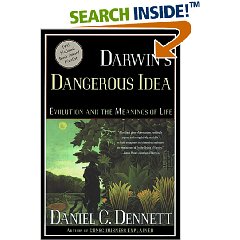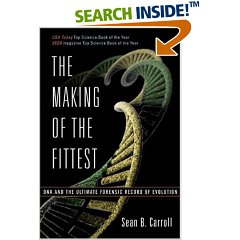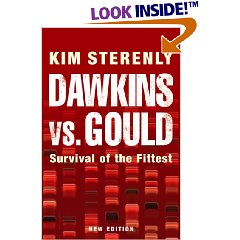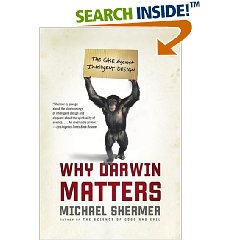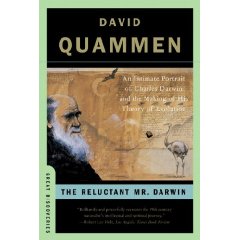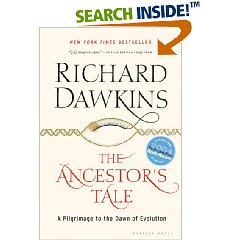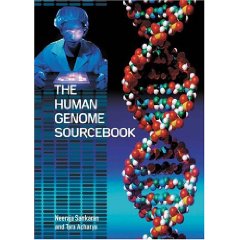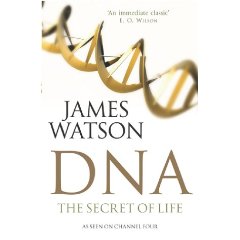Ten Annotated Books on Evolution Theory, Darwin's DNA Part III: Recommended Readings, Andrea Diem-Lane (original) (raw)
TRANSLATE THIS ARTICLE
Integral World: Exploring Theories of Everything
An independent forum for a critical discussion of the integral philosophy of Ken Wilber
 Andrea Diem-Lane is a tenured Professor of Philosophy at Mt. San Antonio College, where she has been teaching since 1991. She received her Ph.D. and M.A. in Religious Studies from the University of California, Santa Barbara. Dr. Diem earned her B.A. in Psychology from the University of California, San Diego, where she conducted original research in neuroscience on visual perception on behalf of V.S. Ramachandran, the world famous neurologist and cognitive scientist. Professor Diem has published several scholarly books and articles, including The Gnostic Mystery, When Scholars Study the Sacred and When Gods Decay. She is married to Dr. David Lane, with whom she has two children, Shaun-Michael and Kelly-Joseph. Also available as e-book. Republished with permission.
Andrea Diem-Lane is a tenured Professor of Philosophy at Mt. San Antonio College, where she has been teaching since 1991. She received her Ph.D. and M.A. in Religious Studies from the University of California, Santa Barbara. Dr. Diem earned her B.A. in Psychology from the University of California, San Diego, where she conducted original research in neuroscience on visual perception on behalf of V.S. Ramachandran, the world famous neurologist and cognitive scientist. Professor Diem has published several scholarly books and articles, including The Gnostic Mystery, When Scholars Study the Sacred and When Gods Decay. She is married to Dr. David Lane, with whom she has two children, Shaun-Michael and Kelly-Joseph. Also available as e-book. Republished with permission.
Part I: Explaining Evolution | Part II: Explaining Consciousness | Part III: Recommended Readings
Darwin's DNA:
A Brief Introduction to Evolutionary Philosophy,
Part 3: Recommended Readings
Andrea Diem-Lane
- Darwin's Dangerous Idea by Daniel Dennett
- The Making of the Fittest by Sean B. Carroll
- Dawkins vs. Gould by Kim Stefelny
- Why Darwin Matters by Michael Shermer
- Darwin Loves You by George Levine
- The Reluctant Mr. Darwin by David Quanmmen
- The Ancestor's Tale by Richard Dawkins
- The Human Genome Sourcebook by Tara Acharya and Neeraja Sankaran
- DNA: The Secret of Life by James Watson
- Nature Revealed: Selected Writings 1949-2006 by Edward O. Wilson
Darwin's Dangerous Idea: Evolution and the Meanings of Life by Daniel Dennett
Daniel Dennett breaks his book up into three sections: the first deals with exactly what Darwin's dangerous idea is; the second section more or less examines the biology of evolution; and third part looks at how Darwinian evolution has transformed our understanding of who and what we are.
Section One:
What is Darwin's dangerous idea? Darwin's idea is the single best idea anyone has ever had, argues Dennett. It is also the most dangerous one. What he means by this is that it burns, like a "Universal Acid," through any misconceptions we have about nature. Special Creation is burned away; the Cosmic Pyramid of God, Mind, Design Order, etc. is annihilated; Plato's essentialism is destroyed; Locke's primacy of Mind is no more. Darwin single handedly demystified the world with his reductionism and usurped all of our traditional understandings in one swoop. He replaced a "skyhook" designer with an algorithmic "crane." And, yes, without a designer, Dennett quipped, there can still be design via this algorithmic process in nature and the statistical probability of design arising after billions of years of hit and miss tries. This is where intelligent design theorists get it wrong: there can be design without a designer. Moreover, this is where "greedy reductionists," who altogether dismiss design apparent all around us, also get it wrong.
Science offers us a totally new perspective of the world and who and what we are, and, hence, science and philosophy forever are intertwined. As with the Copernican Revolution where the shot was heard around the world, Darwin's dangerous idea is still making its way around the world. It took centuries before everyone accepted Copernicus' heliocentric model and it may take the same time or more for the Darwinian Revolution to dominate.
Should we fear this dangerous idea in anyway, asks Dennett? Absolutely not! We just need to grow up, he says, and embrace the underlying beauty of it. Some philosophers have accused Dennett of being the very thing he criticizes, a greedy reductionist. But this seems to be an unfair assessment of Dennett, especially in light of the fact that he yearns to see the magnificence within the natural world via evolution.
Section Two:
I loved the opening quote of this section: "Nothing make sense except in light of evolution" (Theodosius Dobzhansky). This quote sums up the theme of section two. The "Laws of the Game of Life" (i.e., biology which he calls engineering) can only be understood in terms of evolution. The laws and regularities we witness in nature really rely on blind, meaningless chaos. There is no Universal Mind or Wizard of Oz behind the curtain pulling the strings. Instead, the world we live in today is a result of what Crick called "frozen accidents." Sure, Paley witnessed design and he was right to. But design is the accumulation of billions of years of a mindless, algorithmic process. Nietzsche's Eternal Recurrence theme is placed in this section to stress the meaninglessness of life and the only meaning we find is that which we create ourselves.
I especially appreciate his discussion of "intellectual tennis" in section two. Defenders of Special Creation want to play "intellectual tennis" with the net down on their side when serving (referring to not following rules and not offering evidence) but up for the opponent. This is certainly unfair in the field of science.
Finally, Dennett exerts a lot of energy challenging Gould's perspective of evolution and science. He refers to Gould as the "boy who cried wolf" and even had references to him as a "bully." Why is Dennett so taken back by Gould? Well, quite simply, he accuses him of misrepresenting Darwinian evolution. While Gould brilliantly contributed the idea of spandrels to evolutionary theory, his resistance to gradualism, Dennett contends, is off putting. Other controversies, including Teilhard's Omega Point theory, are shot down in this part of the book.
Section Three:
The third section of the book starts with meme theory. Dawkins' memetic understanding of cultural evolution gets the thumbs up from Dennett. Language itself plays a crucial "crane" role in the development of the human mind, though Chomsky has resisted the interplay between Darwinian evolution and linguistics. Instead, Chomsky, along with Searle, contends Dennett, understands the mind more as a "skyhook" than a "crane," especially in both of their rejection of Artificial Intelligence as modeling human intelligence. Moreover, Penrose's meme of Godel's Theorem as proof against AI needs to be "extinguished," says Dennett.
Having highlighted the power of Darwin's dangerous idea still further, Dennett turns his attention to morality and evolution. Are sociobiologists being greedy reductionists by reducing morality to a product of evolution? Certainly, he petitions, we need to understand ethics along Darwinian lines but perhaps not to the level the greedy reductionist would take us. Here Dennett argues that we are not set creatures but that we have the "mind-tools to design and re-design ourselves" and even to re-design moral codes themselves.
In the conclusion of the book Dennett suggests that upon closer inspection Darwin's dangerous idea is not a "wolf in sheep's clothing," but a "friend mistaken as an enemy." Here he is referring to the famous story Beauty and the Beast. Instead of being a terrifying beast, Darwin's dangerous idea is really "a friend of Beauty, and indeed quite beautiful in its own right."
The Making of the Fittest by Sean B. Carroll
In this country we use DNA every day. We use it in the court system and crime scenes; we use it in paternity tests; etc. But, the author asks, why do fifty percent of Americans take issue with implications of DNA in understanding evolution? Since we have mapped out the entire human genome, our comprehension of DNA in the natural world has grown "40, 000 fold." Genomics, the study of DNA, simply overwhelms us with solid evidence of evolution, asserts Carroll.
The author goes to great length to demonstrate through several fascination examples evolution in the natural world. The icefish, a bloodless vertebrate, evolved as it did with the loss of hemoglobin in order to survive freezing temperatures of the Antarctic. Thomas Huxley's "natural selection" (he was the first to coin the phrase) was certainly at work here. Carroll also offers us an example of how DNA itself clearly illustrates evolution. Fossil genes (namely, DNA left over from our ancestors) are found in all species throughout the world.
Referring to his book as "genocentric" (i.e., concentrating mostly on DNA), Carroll wrote The Making of the Fittest for the average layperson with the objective to explain how evolution works. The topic of evolution and the evidence of it need not be an erudite subject reserved for scientists, he says.
Carroll addresses several questions in his effort to clarify to the public what evolution is. For instance, he asks how often do mutations occur in nature? Are they the norm? Carroll walks us through the statistics on this. He explains that among 7 million DNA letters we experience about 175 mutations. But why don't we see mutations on the human species all the time? Most of the mutations occur on what is called "junk DNA," and this is not purged unless its effects are negative. Also, since we carry two copies of genes sometimes mutations do not show up on one gene. Despite all of this, the author refers to us as "all mutants." We are a product of these mutations. It is important to note that natural selection "rejects the changes that are harmful, favors changes that are beneficial, and is blind to changes that are neutral."
What is most fascinating is how many genes we have compared with other species. Homo sapiens possess around 25,000 genes. Many plants, mice and fish carry the same number. Even a worm has 20,000 genes. A fruit fly has two times the genes as yeast and a human has about two times the genes of a fruit fly. As complicated as humans are, why do we not possess more genes than other species? Interestingly, many of our genes are in fact redundant.
In this book we find out that evolution repeats itself many times over. What a great concept! Carroll gives several examples of how evolution does this. For instance, different species develop similar toxins or similar flippers or similar vision. Statistics illustrate that over the vast course of time and having had numerous offspring, "identical or equivalent mutations will arise repeatedly by chance."
The genome of any species contains "a record of the history of life." It holds information about not only its own species but also all the preceding species to the beginning of life on earth. There are about 500 immortal genes (or fossil genes) that all seem to share. The retaining of genes and losing of genes over time demonstrate that there is no concept of progress in evolution. Natural selection is not about design or intent. We are not better adapted than other species of the past. We are just different. William Paley's design arguments falters when one considers, as Darwin did, that vast amounts of time of gradual and sometimes rapid change explains the rich variety of life forms we see today without invoking the notion of a designer.
The anti-evolution movement is lead by the religious right who do not understand genetics and the power of DNA research in proving evolution at play. Creationists do not understand the connection between randomness at the DNA level and natural selection. The author takes great effort to clarify that natural selection does not entail randomness at all. As he says it, "selection, which is not random, determines what chance occurrences are retained." Cumulative selection over eons of time produce the rich tapestry of the organic matter we see today. Evolution is simply the interplay of "chance and necessity." Moreover, Creationists do not understand what a scientific theory entails. It is not an educated guess but "a well substantiated explanation of some aspect of the natural work that can incorporate facts, laws, inferences, and tested hypothesis." The evidence for evolution is overwhelming and it cannot be argued away. There are indeed religious minded people, such as Pope John Paul and the scientist Kenneth Miller, who embrace evolution as factual.
Quoting Peter Medawar, "the alternative to thinking in evolutionary terms is not to think at all." This, Carroll purports, is something we as a species cannot afford. In fact, Carroll ends his book with a chapter on how not understanding evolution has led and will continue to lead to enormous gaffes on the part of humans in nature. Our actions have resulted in destroying balanced ecosystems but it is our responsibility to understand and respect the dynamics of nature. Over-fishing has depleted the waters of certain species of fish; pollution has contributed to the warming of the oceans; many animals are near extinction at our hands. There is no more time to debate the fact of evolution as we destroy elements of this planet. Two centuries of detailed science has moved evolution from the hypothesis stage to the scientific theory stage (that which is supported by a variety of facts, not the least of which is DNA). It is time to wake up and take responsibility, even if out of self-interest, as he put it.
Dawkins vs. Gould: Survival of the Fittest by Kim Stefelny
This book examines the commonalities and, more importantly, major differences between Dawkins and Gould on the theory of evolution.
Let us begin by looking at what they have in common:
- Evolution occurred 4 billion years ago.
- The process was natural, not divine.
- Chance plays a role.
- There is no aim, no purpose.
- There is nothing inevitable about humans.
- Variation in populations leads to varying reproductive chances.
- Natural Selection is essential for evolution: the more fit in the environment has more descendents.
- Natural Selection for humans works slowly over generations but fast for short term organisms.
- Large, random changes are mostly disasters since change must be gradual and cumulative; but on occasion and very rarely there is one big mutation. Overall, though, evolution is generally a long series of small changes.
Differences between Dawkins and Gould abound as well; both represent totally different traditions in evolutionary biology. The focus of this book is on these main differences:
| DAWKINS | GOULD |
|---|---|
| Dawkins looks at ethology and problems of adaptation. | Gould, on the other hand, is a paleontologist who studies fossils; he sees himself as a historian of life. |
| Dawkins focuses on evolution as a history of gene lineages where there are long periods of small changes. Genes replicate almost identical to predecessor. Struggle of evolution is struggle of genes to replicate. Yes, this is reductionistic but genes make the organism. | Gould instead concentrates on extinction and not persistence of gene lineages. He looks at the basic blueprint of animals noting that there are no fundamental new inventions. Gould argues that chance is more important and genes less important. Luck plays a role he says and not just fitness. Catastrophes happen, he points out, and the lucky survive, not the fit. |
| Dawkins carries a different attitude about science than Gould. He is the son of enlightenment who looks at science as the best way to gain knowledge. Science is complete and beautiful, he says; it is open to revision with new evidence and new ideas. Finally, Dawkins argues that science is not to be understood as "the dominate ideology of the time but engine of objective knowledge." | Gould, on the other hand, views science as not complete; there are social influences on scientific views (his book Mismeasure of Man illustrated this). Basically, he argues that the ideology of the time impacts science |
| Dawkins' views on religion vary from Gould's; he is an atheist and sees religion with no authority on values. Religion, he asserts, is a meme, and a destructive one at that. He goes as far as to call religion a virus that we need to get rid of. | Gould argues that science and religion are different domains. Science does not study moral claims where religion does, he states. Gould does not address theism questions though and seems to avoid them altogether. Also, Gould does not support postmodern relativism. |
| Dawkins supports evolutionary psychology - the using of evolution to understand our behavior; he argues that this is a liberating idea since it liberates us from religion. | Gould does not like evolutionary psychology / socio-biology; he argues that it is a dangerous idea that can justify heinous acts like rape. |
| Dawkins argues for natural selection acting on genes/gene lineages Adaptation, quips Dawkins, evolves slowly in small steps with occasional large changes; overtime there is a large range of variation possible. | One the other end, Gould focuses on natural selection on organisms and not genes per se; Gould argues that evolutionary possibilities are constrained since they are basically entrenched. |
Overall, this was a fascinating read on how two respected scientists in the field of evolution can so drastically disagree. What this illustrates, to me, is that science is not a dogmatic discipline but a healthy one full of lively debates that keep inching us along to a more accurate understand of how the world works.
Why Darwin Matters by Michael Shermer
Shermer argues, rightfully so, that the ID movement is mainly a front for creationism. He examines the history of this topic from the Scope's trial to the recent Dover trial. Overall, this reading is a superb source to understand the problems with the ID movement.
There are a variety of problems with the ID movement. Here is a list of some of the major problems Shermer addresses:
- The ID movement is a front for a religious position.
- The Second Law of Thermodynamics is misunderstood.
- Either - or - Fallacy (accept God as Designer or accept total chaos) is prevalent in the ID movement.
- The burden of proof falls on claimant and extraordinary claims require tons of proof.
- The ID movement argues that randomness does not produce the world or apparent design in nature; however, they do not understand that randomness actually builds on itself and so quite significant results can happen rapidly.
- There are multiple creation accounts in the world and there should not be equal time.
Shermer addresses key questions of evolution. Here are some important queries:
- Can you believe in god and evolution? His answer: Yes. He uses the NOMA argument of Gould.
- Should the conservative Christians embrace evolution? Yes. Science need not contradict religion. He uses the Pope John Paul example to show that science and religion can work together.
- Why do we see design? Because we are designed to see a Designer!
- Why is there a shortage of fossils? It is rare to find a fossil since animals in past were eaten as a general rule; however, there are plenty of intermediate forms available today.
The author highlights the evidence of evolution. The following are some examples of the evidence he covers:
- Dawkins' Ancestor's Tale is one of the best compilations of evidence.
- The concept of scientific "theory" is misunderstood; a theory really it is a fact supported by all of the natural sciences and evolution has earned this title.
- Grant's work on finches, a twenty year study, verifies Darwin's data.
Shermer discusses strange designs in nature that evolution explains:
- Males have a form of a uterus off the prostrate gland.
- Males also have nipples.
- Just as apes have a 13th rib so do 8% of humans.
- Humans have a tailbone.
- We have an appendix for digesting cellulose (primal diet was mostly vegetarian).
- Strangely, we have goose bumps and these resemble the raising of animal fur.
In the Epilogue, Shermer's final comments match Chet Raymo's work that the scientific world view does not diminish spirituality or beauty in the world. Science can foster a feeling of spirituality as one feels connected to an infinite universe and "moved to tears" from scientific revelations. Attempting to illustrate how amazing this multi-universe is, Shermer coins a new term he calls "sciensuality, meaning a feeling of awe, humility and sensuality of discovery." Science tells us the story about "who we are, where we come from and where we are going." Thus, he says, Darwin indeed matters.
In the final section of the book, the Appendix, Shermer discusses Eugenie Scott's argument that there are at least 8 different religious views on the creation-evolution issue; these are the following:
- Young earth creationism
- Old earth creationism
- Gap creationism
- Day-age creationism
- Progressive creationism
- ID creationism
- Evolutionist creationism
- Theistic evolution
Darwin Loves You by George Levine
The title of this book, Darwin Loves You, is a take-off of the "Jesus loves you" bumper sticker. But instead of a Christian premise, Levine illustrates that Darwin's research radically enchants the world with a sense of wonder and awe in nature. Much like Chet Raymo's thesis in Skeptic and True Believers, Levine illustrates that Darwin, and science itself, does not in any way de-mystify the world. Rather, scientific research such as Darwin's is able to mystify the world as we are left dumbfounded by the awesome revelations it reveals. Specifically, the Origin of Species gives us an appreciation for how amazing nature is.
Throughout the text the author counters Max Weber's position (as well as William James') that science, following the rational school of thought, disenchants the world and creates a world void of meaning and value. Instead, Levine makes the case that Darwin serves as a model for what Shermer calls "sciensuality." While religion tends to devalue the world, Darwin, argues Levine, offers us a new view. Thus, Weber has it backwards: science is not the one that demystifies the world but religion does. Science offers us a healthy view by explaining the world naturalistically with a deep connection to nature.
Darwin ennobles the earth, he explains clearly, and Weber was simply wrong. In fact, Darwin, through his work, offers "spiritual, cultural, and ethical value." Yet, Levine is talking about a non-theistic enchantment, a wonderment experienced by understanding the world materialistically and naturalistically. For Darwin, matter was not inert or meaningless but alive and vibrant.
Even Darwin's son, William, contended that for his father religion was in nature, and this insight offered religious feelings of awe. More accurately put, science can offer us life with "moments of enchantment." But the author was quick to clarify that moments of enchantment was not necessarily an enchanted life, just glimpse of the magnificence of nature.
Though we live in a wonderful world full of awe, beauty and mystery, it can still be a scary and dangerous place filled with bombs, rapes, slaughters, pain, as John S. Mill pointed out. While science does not justify pain, through science one can explain it. More importantly, the enchantment idea can offer us a reprieve from the pain. For instance, understanding how the eye works via evolution is magnificent and may lessen a feeling of being overpowered by nature and its unexpected turns.
This insight also parallels the "love the earth, our home" theme of Nietzsche when he petitions us to love the world despite the hardships and pains because this earth is our home and all we have and really know. The Ubermensch has the courage to face the world as it is and emerge transformed.
For the author sociobiology and evolutionary psychology are too reductionistic for his taste and contribute, he says, to disenchantment of humans. Just like the 19th century Victorians, scientists such as Pinker, Dawkins and Dennett fit in the reductionistic, positivistic camp. Darwin, while he embraces reductionism, argues Levine, does not fit in the exact same school of thought. Instead, he practices what the author calls "good reductionism" and not "greedy reductionism" or bad science. Levine even places Edward O. Wilson, the author of Consilience, in this radical reductionistic group for explaining humans via genetics. Levine concedes that Wilson has some romantic elements in his consilience theory but enchantment is lost when everything in the natural world is reduced to scientific law.
According to Levine, the affect of awe that Dennett and others miss is found throughout the Origins of Species, almost with "exclamation points." (Note: having read Dennett's work I am not sure this is a fair assessment of him.) What Darwin saw that amazed him, that offered richness and wonder in nature, was the incredible understanding that we are all related, that all of nature is connected. Humans lose their anthropocentric position but in place of it we become part of the greater whole. Epictetus' message of interconnectedness dominates.
There are two more key points that Levine addresses: Darwin was affiliated with biases of his cultural times but in no way does this diminish the validity of his work. And the author looks at the misuse of Darwinian theory to justify social, political aims (e.g., Social Darwianism). He defends Darwin despite abuses of his theory by others because an "is" does not imply an "ought," as Hume brilliantly posited.
The Reluctant Mr. Darwin by David Quanmmen
A wonderful and insightful biography on the life of Darwin, this book focuses on Darwin's life post the Beagle adventure and it makes clear his internal struggle to publish his masterpiece, Origins of Species. Several factors contributed to the delay of publishing it: major physical ailments; family tragedies like the death of two children; and, probably most significant, a fear of society's backlash.
In terms of Darwin's religious background, he was raised both secular and a liberal Christian. The reason he first attended theology school to become a parson was because such a profession allowed him, after the Sunday obligations, the rest of the week to pursue a life as a naturalist. Darwin eventually rejected this career as his theism waned. His theistic perspective was followed by deism and then eventual secular materialism. However, elements of theism are still found in The Origin of Species, published in 1859, when he refers to the Creator. Darwin even quotes William Whewell's "Divine Power" idea as the creator of "general laws."
But is Darwin truly a theist? No. He sees too many questions in nature that forces him to ask: why would a benevolent god create so much cruelty and chaos in nature? Examples of nature's frenzy include the laying of wasp eggs inside a caterpillar so that the larva could eat the host upon hatching. Even the death (most likely from tuberculosis) of his favorite and oldest child, Annie, shows the "problem of evil" that Darwin never seems to reconcile.
The author brilliantly argues that Darwin does not really challenge the existence of god as he does the godliness of man. By this saying this, Darwin is concentrating on the interconnectedness of all of nature, of all life forms, and the humans do not stand apart from or above it. Darwin refers to this interconnection as the "grandeur of life."
This grandeur is clearly illustrated when we compare the human genome with that of a mouse's. The 30,000 genes that we both have are 99% direct "counterparts" (meaning very similar but not identical as a chimp and a humans are). Life is from one original source. Embryology shows that we have signs in the embryo state of the progenitor before (e.g., tail, gills, body hair, etc.)
Biogeography, a field that deals with the spread of animal and plant distribution on the planet, was of particular interest to Darwin. He was fascinated with how life forms can be spread across the world. Seeds survive in animal feces and are passed to other areas. Clams hook on to water bettle's legs and as they catch a ride develop habitat elsewhere. Interestingly, the last clam/bettle specimen Darwin was given came from the grandfather of Francis Crick.
What was Wallace's role in this field? He sent Darwin a manuscript detailing his evolution ideas that included transmutation and natural selection (the latter was not coined by Wallace) prior to the publishing of The Origin of Species. Darwin, along with his scientist friends, decided to give Wallace co-recognition in a paper at a science lecture on the topic. Darwin then was given the impetus to overcome his prior reluctance, fearing that someone would gain priority in the field. The Origins of Species shortly followed, selling out of first edition copies on the first day of sales. Both scholars argued for gradualism and against Lamarkianism, but later on Wallace, a supporter of spiritualism, argued that natural selection could not account for the development of the human brain. Darwin refers to Wallace's slip into spiritualism as intellectual suicide.
Overall, this book was quite an enjoyable biography. It offers insights to Darwin's personal life that make his scientific endeavors even more impressive.
The Ancestor's Tale by Richard Dawkins
Dawkins begins his tale by explaining that humans are pattern, meaning seeking creatures. Being the pattern seeking creatures that we are, humans look at the history of the world and believe that it was fine-tuned to bring humanity into existence (basically, this is the anthropic principle). He refers to this as the "conceit of hindsight." Our conceit is the belief that the past works to deliver the present, namely us, and so humans are the final goal in evolutionary history.
But is evolution progressive? No, argues Dawkins, not at all. We are wrong to think that our predecessors were transitional beings and a halfway mark to us. The idea of us being "more evolved," however, comes from an incorrect, human centric perspective. Dawkins humorously points out that if elephants could write history they would see everything as leading up to the development of the trunk.
This text takes a different approach to understanding evolutionary theory. Instead of starting with the earliest forms and showing the diversity of life, Dawkins goes backwards, beginning with humans, to show the unity of life. This backward approach traces humans back to a shared ancestor with the apes, more than 18 million years ago and eventually back to the progenitor of all, the bacterium. The point of a shared ancestor, the moment of a rendezvous of a last common ancestor, is called a "concestor." Is there a concestor of all life forms? Yes, since we share a common genetic code with all of life on this planet. The Grand Concestor of all life forms, bacterial fossils, dates 3.5 billion years ago.
Dawkins adventure begins with the Homo sapiens as he pilgrimages from the present to the past common ancestor. On our journey the first pilgrims we meet are the chimps 5 million years ago. This is followed by the gorillas, then the orangutans, to the gibbons, to the old world monkeys, then to other mammals and eventually to the first form in the sea.
There are only 40 rendezvous points in the human pilgrimage to the origin of life. In other words, there are 40 steps or 40 concestors in our history to the first life form. Concestor number 39 is the grand ancestor of all life forms. These 40 natural milestones is a literary allusion to Chaucer's Canterbury reference of a pilgrim's tale.
Dawkins points out three main methods to understanding evolution: archeology (hard relics such as fossils, etc.); renewed relics such as DNA; triangulation, that is, triangulating an ancestor by comparing two surviving descendents. Let us look at each of these briefly:
- Fossils: fossils demonstrate evolution but even if there are gaps in the fossil records there is overwhelming evidence of evolution; fossils are just a bonus.
- DNA: the alphabet of DNA is a like a writing system that records and copies. DNA changes very slowly so the record is woven into all plants and animals. Four letters allows for 64 limited words. There is a 64 word DNA dictionary that is universal and unchanging. DNA, argues Dawkins, is the genetic book of the dead, a chronicle of the past.
- Triangulation: this is the comparison of DNA sequences of species and a look for shared DNA; for instance, comparing human and bacteria DNA to find overlap and resemblances. An analogy would be a similarity of languages like German and Dutch. But human and chimp DNA is so similar it is like English spoken in two slightly different accents but still English nonetheless. The analogy continues when you compare English and Japanese---there are no two organisms that can compare to the great differences between these two languages, not even humans and bacteria. All of this shows a definite family tree among organisms.
The actual pilgrimage now begins. If we look at the first tens of thousands of years (say 50,000 years ago) there really is no genetic difference than we are today. There are two major cultural advances in the last 50,000 years: agricultural revolution (farmer) and Cro-Magnon's tale (the flowering of the human mind). The farmer's tale was an agrio-revolution that began 10,000 years ago at the end of the last ice age and is called the new stone age or Neolithic. There is a transition from the hunter-gatherer and a new idea of home. At this time large populations are supported but diseases are now a threat; domestication, farming and urban life are central. This period was preceded by what Dawkins calls the cro-magnon tale. It began 40,000 years ago as the hunter-gather society was dominant with music, figurines, graves, paintings, carvings, etc. There was no longer a million year stagnation but the flowering of consciousness in the Homo sapiens; some even attribute this to the origin of language.
Dawkins speaks a great deal about concestor 0. But what is concestor 0? It is the most recent ancestor of all surviving humans. MRCA refers to the most recent common ancestor. Mitochondrial DNA MRCA is called mitochondrial Eve; for males the MRCA is called y-chromosome Adam. Adam and Eve could actually be separated by tens of thousands of years; Eve most likely preceded Adam; she was probably 140,000 years ago and Adam 60,000 years ago.
Rendezvous 0 refers to tens of thousands of years ago to hundreds of thousand at most. And Rendezvous 1 refers to the fork between humans and chimps millions of years ago. Dawkins makes an interesting claim that you may be more related genetically to a chimp than to some humans. One big difference between humans and chimps, though, is the FOXP2 gene. This FOXP2 gene is the gene that allows humans to have language. Since chimps lack this gene they also lack language as we have.
An interesting question is: are we related to the Neanderthals? And is there interbreeding between Neanderthal and humans? Most likely the answer to both of these is no since mitochondrial Eve does not match them; few if any genes of ours come from them.
Homo ergaster or Homo erectus lived one million years ago. And actually they were no more erect than predecessor Homo habilis. They are altogether a different species than us. Moreover, it is not conclusive if they used fires but there is some evidence of campfires; tools were used and we are not sure if they had developed some form of language.
Homo habilis lived two million years ago and are referred to as the Habilines. What is unique about them? These handymen from Africa had larger brains; 750 cc brain was significant since the larger brain now fits the homo category. The Autralopithecus was its predecessor.
The brain size of the Homo sapiens is 6 times larger than it should be for a typical mammal of equivalent size. The Homo habilis is about 4.5 times bigger than it should be and a Homo erectus is about 4 times larger. For a chimp its brain is about 2 times larger than it should be for a mammal that size. What accounts for the EQ (encephalisation quotient) of humans? There are various theories that Dawkins considers. Certainly, it is our brain size that makes us a bit unique but in no way superior.
Australopithecus afraenis lived 3.2 million years ago; Lucy, a bipedal being, is an example of this found in Ethiopia in 1974. Why the rise to bipedal? There are numerous theories; these include: having extra height to see; squat feeding to turn over rocks looking for insects; freeing of hands to carry food; having less sun on the body. Dawkins argues that there may be several factors that account for it. Little Foot is a 4 million year old bipedal fossil whose toes also suggests tree climbing too.
Overall, the Ancestor's Tale is an essential read to further one's knowledge on the subject of evolution. Michael Shermer, in Why Darwin Matters, goes as far as to call the book one of the greatest compilations on evolution ever. And certainly I agree.
The Human Genome Sourcebook by Tara Acharya and Neeraja Sankaran
This textbook is essentially a summary of the 1990s Human Genome Project, also referred to as the "Book of Life," or the "blueprint" or "recipe book." The recipe is the genome, derived from the words gene and chromosome.
While the Human Genome Sourcebook was written with the general reader in mind, it is still scientifically challenging. The authors refer to their work as a reference volume and certainly that is what it is. This reference text begins with a historical overview of heredity beginning with Lamark's, Darwin's and Mendel's research. It then continues to give a history of genetics. In the early 1900s William Bateson coined the term "genetics," referring to genesis of traits. Some of the first genetic research on chromosomes began with Thomas Morgan's work on fruit flies at Columbia University in the early 1900s.
- Here is some of the information catalogued within the text:
- DNA inside each cell, if stretched out, would be over 6 feet long.
- Chromosomes vary with each species: while humans have 23 pairs, a peanut has 20, a dog has 39 and a sugar cane has 40 pairs.
- The entire human genome consists of 3.1 billion base pairs.
The text highlights the numerous ethical concerns regarding genetic research, namely genetic profiling and eugenics.
A large portion of this book is dedicated to defining genetic terms and concepts from genotype to mitochondrial DNA. An understanding of chromosomes and genetic diseases follows the term section. Cancer, diabetes, lupus and the like are genetically explained.
While reading the text my focus was on evolution: correctly explained was the idea that apes or monkeys did not give rise to humans, but that we share a common ancestor with them. The authors clarified that evolution occurs at a slower rate the larger the genome size. Our 3 billion base pairs results in a slower rate of change than species with a smaller number of base pairs.
While not per se entertaining, one learns a lot within the pages and so it was, overall, a worthwhile read.
DNA: The Secret of Life by James Watson
James Watson, co-founder of the structure of the DNA molecule, begins with a discussion of the origins of genetics. Interestingly, he points out that it really began with the Greeks, including Hippocrates. Pangenesis (the transfer of miniature parts of the body via sperm/egg) was a popular idea of the time. Even Darwin entertained pangenesis to explain inheritance, since he was unaware of Mendel's breakthrough research on genetics. Pangenesis idea was finally decimated when amputated tailless mice kept producing offspring with tails. As in the Human Genome Sourcebook, Morgan's research on fruit flies was discussed; fruit flies make a great specimen since a new generation only takes ten days and a female lays hundreds of eggs.
Francis Galton in the 19th century introduced eugenics, meaning "good in birth." Even George Bernard Shaw referred to eugenics as that which "can save our civilization." There were two approaches: Galton's positive eugenics that encouraged gifted people to procreation; and negative eugenics that tried to prevent those viewed as not superior from reproducing. The IQ test in the early 20th century contributed to a fear that bad genes were entering American soil. Henry Goddard argued that immigrants were the cause of the downward spiral of American intelligence. Theodore Roosevelt bought the argument. Sadly, racism, while not inherent to eugenics, became connected to it. Hitler became part of the movement as well.
Watson retells the story of how he and Crick discovered the structure of the DNA molecule. One competitor scientist was Rosalind Franklin, who died at 37 of ovarian cancer. Feb. 28th, 1953 marks the day the discovery was made. Vitalism was put to an end at this time. Soon after the discovery of the structure of the DNA molecule, evidence of genetic mutation was conclusively demonstrated. Usually A and T matched up and C and G matched up; but on occasion there was a genetic mix up and the sequence changed.
Several interesting chapters, such as the ones on biotechnology and genetically modified agriculture, followed the explanation of the DNA structure. The human genome project receives special attention.
My favorite section was chapter nine on DNA and evolution where our human past is examined. Homo neanderthalensis can be dated 30,000 years ago and are described as a different yet similar species to our own. They had slightly larger brains and there is evidence they buried the dead and may have believed in an afterlife. DNA solved the mystery of our relations to them. When one scientist working on the DNA sequencing referred to the excitement as "something starting to crawl up my spine" I was reminded of Chet Raymo's argument that good science produces a "shudder up the spine."
Strangely, it turns out that we were more closely related to Neanderthal than to chimpanzees and so Neanderthals are considered part of the human tree (a branch but not part of the same limb). However, we do not see Neanderthal genes mixed with ours so interbreeding is suspect. While we are genetically different than the Neanderthal, this research indicates how connected we are overall with the natural world.
One question that caught my attention was: at what point did the human lineage separate from the chimps and gorillas? Mary-Claire King's research indicated it occurred no more than 5 million years ago. And she also showed that humans and chimps differed genetically only by 1%. Gorillas and chimps differ by 3%. So we are closer to chimps than they are to gorillas.
Watson clarifies that the ancestor of all humans arose in Africa. And, interestingly, we can trace a common ancestor to all humans no more than 150,000 years ago.
Humans are almost genetically identical with each other. We are 99.9% alike. Variation among humans is very little compared with other species. Fruit flies are 10X more variant and chimps are 3X more variant. Why are humans so alike, Watson asks? He argues it is because our common ancestor was so recent, only 150,000 years ago, and this was "insufficient time for substantial variation to arise through mutation."
Watson makes the claim that under the fur of a chimp their skin is white. And that since we were connected to them genetically with a common ancestor 5 million years ago, black skin pigmentation later arose in human evolution to protect African skin from damaging sun rays (certainly necessary without as much body hair).
Though we are only 1% genetically different than chimps this is enough to account for enormous phenotype differences. For instance, we have language and they do not. The gene to account for why humans developed language and chimps did not is called the FOXP2 gene.
Near the book's end there is an important section on Edward O. Wilson's work on evolutionary psychology. Watson argues that Wilson's pivotal 1975 work should move from the "fringes of anthropology to the very heart of the discipline."
And, finally, Watson concludes his book was an argument for human genetic enhancement. But this idea has sometimes received a harsh reception, as it did when it was presented in Germany several years ago. Watson understands the ethical implication of this but hopes for a world with less disease and pain.
This reading reveals the wonderful awesomeness of DNA and a world so intimately connected through it. James Watson deserves applause for illuminating the "secret of life."
Nature Revealed: Selected Writings 1949-2006 by Edward O. Wilson
Edward O. Wilson compiled some of his classic work into this masterpiece. Highlighting the history of sociobiology, Wilson also spotlights a better integrated science known as "consilience." Both of these topics are indeed powerful tools to "reveal nature." Let us look at sociobiology and consilience separately:
Sociobiology:
Interestingly, Wilson's work began in 1949 with the study of fire ants. One question he asked was: Why is there a sterile caste in ants? He discovered that the unit of natural selection is the family unit and not the individual. Sterile ants work as helpers to serve reproductive interests of the family unit. Furthermore, his study of ants revealed that ants occupy the land for 100 million years. One form of social adaptation is slavery. Ants raid nests and make captives slaves.
Moreover, Wilson's work on ants led him to study pheromones. When pheromones where discovered in animals, Wilson's study of ants invisible odor served as strong evidence of these hormones. In 1963 there is the first notion of these hormones in humans.
In 1975 Wilson completed Sociobiology: The New Synthesis. While sociobiology was applied to animals in 1971, it was now applied to humans four years later. This new discipline eventually led to evolutionary psychology.
Evolutionary psychology shows that human decency / altruism arises from genes favoring them. Moral philosophy or ethics, as well as religion, can be explained with biology. Furthermore, Wilson explores the link between genetic evolution and cultural evolution....from genes to neural, mental development to mind to culture.
Wilson notes that there is a misunderstanding about sociobiology: it is not a belief that human behavior is genetically determined. But, according to Wilson, it is: "the study of the biological basis of all forms of social behavior in all organisms."
In 1980 Wilson focuses on global conservation movement and he becomes one of the fathers of this movement. One of his biggest fears is the loss of biological diversity as a result of humans. However, when discussing conservation ethics, he explains that biophilia is our natural affinity for life and our innately emotional affiliation with other organisms. Wilson points out that 99% of human history was hunter-gatherer bands and they were so intimately involved with life and organisms. Thus, the brain evolved, he argues, as biocentric.
Consilience:
Wilson's work on consilience work began in 1998. It is an attempt to connect natural science with social science/humanities. The term means "jumping together" of different fields of study. He refers to it as an "integrated science," where various disciplines are interlocked and reducible to the same general laws of nature.
The author dates the true origins of consilience with Thales of the 6th century BCE who appeared to be interested in a common network of explanations. With consilience, complex biological phenomena are reducible to the simple. For instance, biology can be explained in part by chemistry, which is in part can be explained by physics and then by quantum physics.
In today's age, there is now a connection between the natural science and the social sciences: neuroscience, psychology, philosophy are intertwined. Neural activity explains consciousness and consciousness explains culture. Thus, the mind has a "reducible material basis." Wilson argues that the social science will advance with consilience as it takes the reductionistic approach to human nature.
Now it can be argued that genetic evolution is linked directly to cultural evolution. Epigenetic rules determined by neurology / brain states established cross cultural universals (such as taboos against incest, fear of snakes, etc.)
Integrated science produces winners all around as it illustrates causally linked phenomena. There need not be distinct branches of learning but each is strengthened by assimilation. Overall, Wilson points out the obvious causal links between genes, mind and culture. As we are baffled by the meaning of our existence, an integrated understanding of the world is indeed necessary. Thanks to Wilson's seminal work, "nature is revealed" through this line of thinking.
